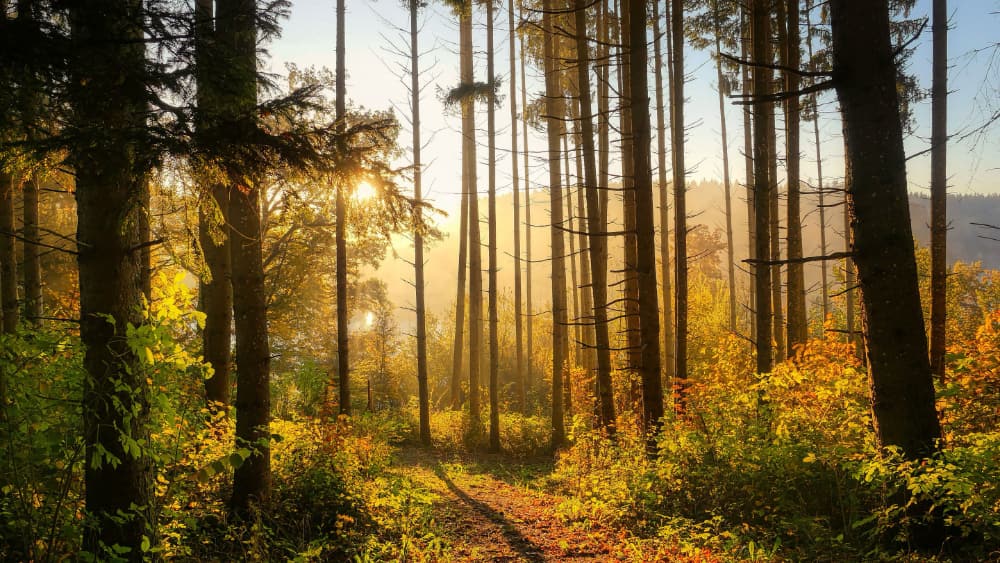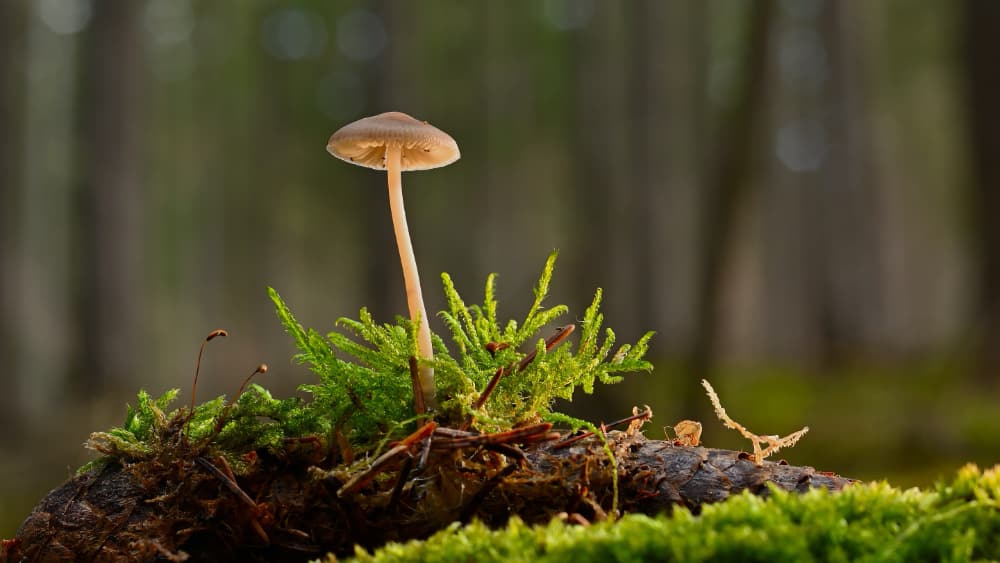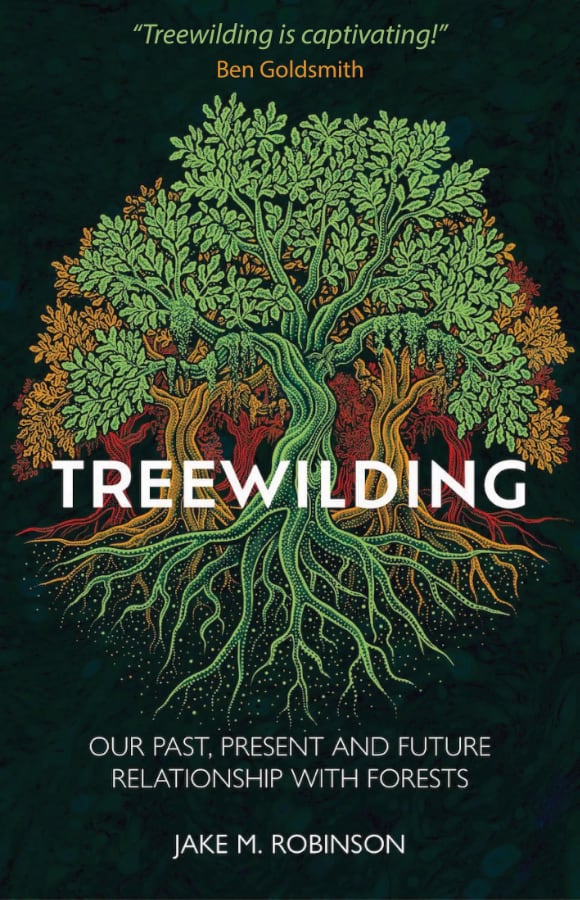Treewilding “Seeing the woods (complex ecosystems) for the wood (timber)”
It’s a great feeling to finally share my new book, Treewilding, with the world. I explore how to restore global forests and our relationship with them. Along the way, there’s cutting-edge science, Indigenous perspectives, controversies, hope and solutions.
And so, the journey begins. I’m sitting on a log, watching the crispy leaves from a nearby forest dancing in the breeze; winter’s chilly promise is just around the corner. The rocks are hugged by a fluffy cloak of moss, their edges decorated by algae, like glistening jade necklaces. The log’s bark is covered in sunburst lichens and a stand of curly bracken embellishes the margins in the distance. There are no mature trees, but tree saplings are dotted across the landscape. They were planted here by humans, and now they compete and maybe even cooperate as their young branches and leaves with tiny chlorophyll parcels reach for the sky. Some saplings will hopefully survive and grow into a flourishing community. Many dangers lie ahead for them, but in the right conditions, nature is remarkably resilient. This is the start of a forest restoration project – a local story of hope. And what better symbol of hope than the seed of a tree, fragile yet brimful of potential?

Globally, we’re on the brink of unprecedented biodiversity loss and climate chaos, making ecosystem restoration crucial. However, these efforts often fail when they ignore the livelihoods of local communities, lack ecological insights, or overlook Indigenous leadership. Our disconnection from nature, especially in affluent societies, hinders effective restoration. Indeed, true restoration requires a shift from a mindset of control and convenience to one of reciprocity and belonging.
As Aldo Leopold famously said, “There are two spiritual dangers in not owning a farm. One is the danger of supposing that breakfast comes from the grocery, and the other is that heat comes from the furnace”. The same concept applies to paper and timber. How often do we think about where paper comes from? As our connection with nature weakens, is there a spiritual danger in supposing that paper comes from the stationery shop and not the forest – a complex ecosystem? Having written a book on restoring forests, I feel the need to acknowledge the sacrifice of nature in facilitating the delivery of these words. Each page of this book is a gift from nature. Each page was once part of a functioning ecosystem, a forest, a dynamic community of life. When we disconnect the product from its source, we risk devaluing the interdependence of life. Indeed, many of us now live in a world of luxury where convenience is experienced at the click of a button. But it’s important to take the time to appreciate our evolutionary roots, the roots of our convenience and the roots of our destruction. It’s also important to understand the multifaceted values of trees and forests, support the rich bounty of knowledge of different cultures and build on restoration successes. By doing so, we can shape the future in wonderfully positive ways and cultivate a deeper respect and reverence for the natural world.

What does a tree mean to you?!
A tree is myriad things, transcending the boundaries of objectivity. A tree is a subject and a living community. A paper mill owner may see a tree as a resource, pulp-to-be. Living trees can be ancient. They’ve lived through medieval history, quietly witnessing our tragic and halcyon days. Some trees burst from their seeds and anchored their roots several millennia ago. Indeed, some living trees are nine times older than the first paper mill established in Nuremberg, Germany, in 1390. These trees continue to inhale our exhalations today as we inhale theirs. Carl Sagan famously said that it’s a “marvellous cooperative arrangement … a planet-wide mutual mouth-to-stoma resuscitation”.
Trees are vital habitats for countless species and essential parts of ecological communities. As ‘holobionts’, trees support and rely on vast networks of bacteria, fungi, and other microorganisms. Indeed, a forest is as invisible as it is visible and everything we can see in nature intimately depends on everything we can’t see. One of my aims of Treewilding is to emphasise the importance of these underappreciated perspectives.
Indigenous cultures often view trees as community members, not mere resources––perhaps a critical omission from capitalist societies. In urban areas, trees provide shade, regulate water, remove pollutants, and even emit health-promoting microbes. Their fractal patterns soothe our minds, and their presence encourages play and community. Trees, like all plants, have senses. They can perceive, learn, remember, and solve problems. While they lack brains or neurons, their abilities resemble cognitive functions. Trees might even communicate, protect, and nurture each other, acting as families in their ecosystems – although as you’ll learn in Treewilding, this is hotly debated. The now famous ‘wood wide web’ concept where fungi help trees communicate in a vast biological internet has been deeply scrutinised as of late. I discuss both sides of the argument – the ‘mutualistic friendly’ camp and the fungi and trees as ‘market traders’ camp. Still, one thing is for sure: fungi and microbes are vital for forest health, whether they are being cooperative spiteful, altruistic, reprimanding – or all or none of the above.

Forests, too, are more than groups of trees. They are networks of life, with layers from the forest floor to the towering canopy, each supporting diverse forms of life. Forests are places of belonging, resilience, and interconnection. They hold intrinsic value, independent of human use, and instrumental value as homes, resources, and sources of wellbeing. My childhood memories are filled with time spent in forests, climbing trees, and finding solace in their canopies. As an ecologist, I continue to find peace and connection in these environments. Restoring forests means restoring these connections, not just for the ecosystems but for our own sense of belonging and meaning.
Among examples of innovative solutions to our planet’s issues, there’s a fair sprinkling of controversy to talk about. For instance, planting trees where they don’t belong can do more harm than good and there’s a greenwashing tidal wave to avoid. However, in Treewilding, I discuss ways to avoid falling into these nefarious traps while highlighting the many rays of hope we should embrace. This journey into forest restoration is about more than science; it’s about embracing other worldviews, fostering reciprocal relationships, and promoting a life-affirming future. Through understanding and respect, we can protect our forests and the myriad forms of life they support, ensuring a thriving planet for generations to come.
Treewilding is in bookstores from August 1st 2024, and can be purchased online: pelagicpublishing.com/products/treewilding
You may also enjoy Jake’s other book Invisible Friends: How Microbes Shape Our Lives and the World Around Us
Why not visit Julia Loves to discover more outdoor and nature titles?


